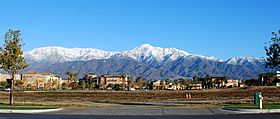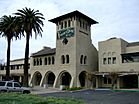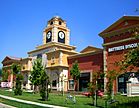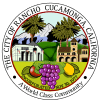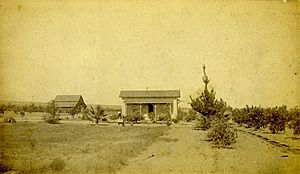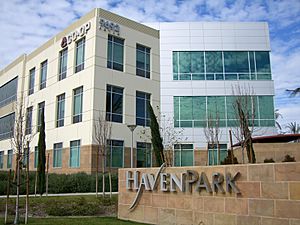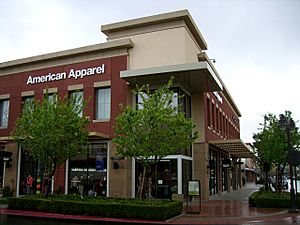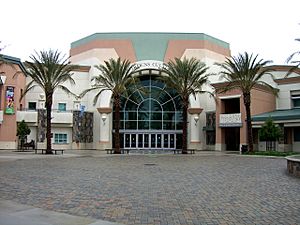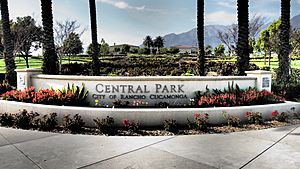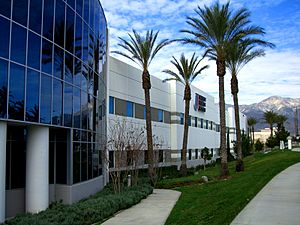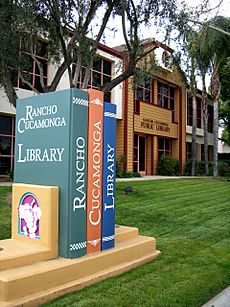Rancho Cucamonga, California facts for kids
Quick facts for kids
Rancho Cucamonga
|
|||
|---|---|---|---|
|
Cucamonga Peak (top), Virginia Dare Winery (left), and shops in Rancho Cucamonga (right)
|
|||
|
|||
| Motto(s):
A World Class Community
|
|||
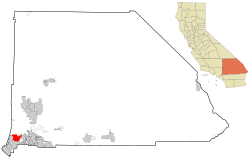
Location of Rancho Cucamonga in San Bernardino County
|
|||
| Country | United States | ||
| State | California | ||
| County | San Bernardino | ||
| Incorporated (city) | November 30, 1977 | ||
| Government | |||
| • Type | Council-Manager | ||
| Area | |||
| • Total | 40.12 sq mi (103.91 km2) | ||
| • Land | 40.11 sq mi (103.89 km2) | ||
| • Water | 0.01 sq mi (0.02 km2) 0.05% | ||
| Elevation | 1,207 ft (368 m) | ||
| Population
(2020)
|
|||
| • Total | 174,625 | ||
| • Estimate
(2023)
|
174,405 | ||
| • Rank | 4th in San Bernardino County 26th in California 152nd in the United States |
||
| • Density | 4,349.36/sq mi (1,679.21/km2) | ||
| Time zone | UTC−8 (PST) | ||
| • Summer (DST) | UTC−7 (PDT) | ||
| ZIP Code |
91701, 91729, 91730, 91737, 91739
|
||
| Area code(s) | 909, 840 | ||
| FIPS code | 06-59451 | ||
| GNIS feature ID | 1667908 | ||
Rancho Cucamonga (/ˌræntʃoʊ kuːkəˈmʌŋɡə/ ran-CHOH-_-KOO-kə-MUNG-gə) is a city located just south of the foothills of the San Gabriel Mountains and Angeles National Forest in San Bernardino County, California, United States. About 37 mi (60 km) east of Downtown Los Angeles, Rancho Cucamonga is the 28th most populous city in California. The city's seal, which centers on a cluster of grapes, alludes to the city's agricultural history including wine-making. The city's proximity to major transportation hubs, airports, and highways has attracted the business of several large corporations, including Coca-Cola, Frito-Lay, Big Lots, Mercury Insurance Group, Southern California Edison, and Amphastar Pharmaceuticals.
The city had a population of 174,453 according to the 2020 United States Census.
The Jack Benny Program popularized the city's name, in particular the word "Cucamonga".
Contents
History
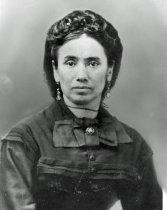
By 1200 AD, Kukamongan Native Americans had established a village settlement in the area around present-day Red Hill, near the city's western border, where Red Hill Country Club stands today. Kukamonga derives its name from a Tongva word meaning "sandy place." Anthropologists have determined that this cluster of settlers likely belonged to the Tongva people or Kich people, at one time one of the largest concentrations of Native American peoples on the North American continent. In the 18th century, following an expedition led by Gaspar de Portola, the land was incorporated into the Mission System established by Father Junipero Serra and his group of soldiers and Franciscan friars.
After a half century of political jockeying in the region, the land finally came under the control of Juan Bautista Alvarado, governor of Mexico. On March 3, 1839, Alvarado granted 13,000 acres (5,300 ha) of land in the area called "Cucamonga" to Tubercio Tapia, a first-generation Spanish native of Los Angeles, successful merchant, and notorious smuggler. Tapia went on to establish the first winery in California on his newly deeded land. Rancho Cucamonga was purchased by John Rains and his wife in 1858. The Rains family's home, Casa de Rancho Cucamonga, was completed in 1860 and now appears on the National Register of Historic Places.
During the ensuing years the town prospered and grew. In 1887, irrigation tunnels were dug into Cucamonga Canyon by Chinese laborers and the Santa Fe Railroad was extended through the area. Among the town's economic mainstays was agriculture, including olives, peaches, citrus, and, most notably, vineyards. In 1913, the Pacific Electric Railway was extended through Rancho Cucamonga in an effort to improve crop transportation. Several landmarks in existence today pay tribute to the city's multicultural founding. In particular, Our Lady of Mt. Carmel remains as a relic of the area's Mexican agriculture laborers while the Chinatown House stands as a reminder of the Chinese immigrants who labored in constructing the area's infrastructure.
In 1977, the unincorporated communities of Alta Loma, Cucamonga, and Etiwanda voted to incorporate, forming the city of Rancho Cucamonga.
Grapeland
The former community of Grapeland, first settled in 1869, lay roughly between today's Victoria Groves Park and Central Park. There was a schoolhouse which also doubled as a church. In 1890 an irrigation district was formed and $200,000 in bonds were sold to pay for improvements. The Sierra Vista reservoir was built in 1886-87 by J.L. Scofield as the focal point of a network of irrigation pipes. The system was unused, however, because the bond issue was declared illegal. "Orchards and vineyards began to die," The Daily Report newspaper reported in a retrospective. "Residents moved out. The post office closed in 1905. Homes, buildings were destroyed or abandoned." The reservoir remained unused until 1956, when the Fontana Union Water Company filled it with 5 million US gal (19 million L) of water. The local school district was merged with the Etiwanda district in 1901. In 1957 the settlement was practically deserted, but there were still rabbit-proof stone walls marking boundaries of previous citrus orchards.
Geography
Rancho Cucamonga is part of the Inland Empire and San Bernardino County, a region that lies inland from the Pacific coast and directly east of Los Angeles County. Rancho Cucamonga is located about 37 mi (60 km) east of Los Angeles, bordered by Upland to its west, Ontario to its south, the San Gabriel Mountains to its north and I-15 and Fontana to its east. Situated on an alluvial plain with a wildland–urban interface, bears occasionally wander through. Views of Cucamonga Peak, one of the tallest peaks of the San Gabriel Mountains, are available. The city has a total area of 39.9 sq mi (103 km2), of which 99.95% is land and 0.05% is water.
Climate
The city's climate is classified as hot-summer Mediterranean, or Csa, under the Köppen climate classification system. Summers are long and hot, and winters are generally comfortable with occasionally chilly days. Yearly precipitation is 17.68 in (449 mm) and the city experiences an average of 287 sunny days per year, compared to a national average of 205 days.
| Climate data for Rancho Cucamonga, California (1987–2016; extremes since 1909) | |||||||||||||
|---|---|---|---|---|---|---|---|---|---|---|---|---|---|
| Month | Jan | Feb | Mar | Apr | May | Jun | Jul | Aug | Sep | Oct | Nov | Dec | Year |
| Record high °F (°C) | 90 (32) |
90 (32) |
97 (36) |
110 (43) |
107 (42) |
115 (46) |
112 (44) |
111 (44) |
112 (44) |
110 (43) |
98 (37) |
93 (34) |
115 (46) |
| Mean daily maximum °F (°C) | 66.2 (19.0) |
68.5 (20.3) |
69.3 (20.7) |
74.3 (23.5) |
79.0 (26.1) |
86.0 (30.0) |
93.9 (34.4) |
93.7 (34.3) |
89.4 (31.9) |
82.2 (27.9) |
72.3 (22.4) |
66.9 (19.4) |
78.4 (25.8) |
| Mean daily minimum °F (°C) | 41.4 (5.2) |
43.0 (6.1) |
44.1 (6.7) |
46.9 (8.3) |
51.4 (10.8) |
55.9 (13.3) |
61.2 (16.2) |
62.1 (16.7) |
59.0 (15.0) |
53.2 (11.8) |
45.7 (7.6) |
41.4 (5.2) |
52.5 (11.4) |
| Record low °F (°C) | 25 (−4) |
29 (−2) |
30 (−1) |
33 (1) |
38 (3) |
43 (6) |
52 (11) |
51 (11) |
47 (8) |
40 (4) |
26 (−3) |
24 (−4) |
24 (−4) |
| Average rainfall inches (mm) | 4.16 (106) |
5.14 (131) |
2.70 (69) |
1.10 (28) |
0.44 (11) |
0.21 (5.3) |
0.07 (1.8) |
0.04 (1.0) |
0.25 (6.4) |
0.93 (24) |
1.22 (31) |
1.42 (36) |
17.68 (450.5) |
| Average rainy days (≥ 0.01 inch) | 7.2 | 6.7 | 7.7 | 4.1 | 2.8 | 1.6 | 0.5 | 0.7 | 1.7 | 2.6 | 3.4 | 4.8 | 43.8 |
Demographics
| Historical population | |||
|---|---|---|---|
| Census | Pop. | %± | |
| 1980 | 55,250 | — | |
| 1990 | 101,409 | 83.5% | |
| 2000 | 127,743 | 26.0% | |
| 2010 | 165,269 | 29.4% | |
| 2020 | 174,453 | 5.6% | |
2020
| Race / Ethnicity (NH = Non-Hispanic) | Pop 2000 | Pop 2010 | Pop 2020 | % 2000 | % 2010 | % 2020 |
|---|---|---|---|---|---|---|
| White alone (NH) | 70,028 | 70,572 | 59,931 | 54.82% | 42.70% | 34.35% |
| Black or African American alone (NH) | 9,789 | 14,486 | 15,237 | 7.66% | 8.77% | 8.73% |
| Native American or Alaska Native alone (NH) | 405 | 409 | 357 | 0.32% | 0.25% | 0.20% |
| Asian alone (NH) | 7,469 | 16,741 | 25,186 | 5.85% | 10.13% | 14.44% |
| Pacific Islander alone (NH) | 292 | 383 | 387 | 0.23% | 0.23% | 0.22% |
| Other Race alone (NH) | 294 | 400 | 987 | 0.23% | 0.24% | 0.57% |
| Mixed race or Multiracial (NH) | 3,975 | 4,590 | 7,107 | 3.11% | 2.78% | 4.07% |
| Hispanic or Latino (any race) | 35,491 | 57,688 | 65,261 | 27.78% | 34.91% | 37.41% |
| Total | 127,743 | 165,269 | 174,453 | 100.00% | 100.00% | 100.00% |
German, Irish and English were the most common ancestries. Spanish was the second most common language.
2010
The 2010 United States census reported that Rancho Cucamonga had a population of 165,269. The population density was 4,145.2 inhabitants per square mile (1,600.5/km2). The racial makeup of Rancho Cucamonga was 102,401 (62.0%) White (42.7% Non-Hispanic White), 15,246 (9.2%) African American, 1,134 (0.7%) Native American, 17,208 (10.4%) Asian, 443 (0.3%) Pacific Islander, 19,878 (12.0%) from other races, and 8,959 (5.4%) from two or more races. There were 57,688 residents of Hispanic or Latino ancestry, of any race (34.9%).
The census reported that 162,145 people (98.1% of the population) lived in households, 136 (0.1%) lived in non-institutionalized group quarters, and 2,988 (1.8%) were institutionalized.
Out of a total of 54,383 households, 23,055 (42.4%) had children under the age of 18 living in them, 30,533 (56.1%) were opposite-sex married couples living together, 7,514 (13.8%) had a female householder with no husband present, and 3,257 (6.0%) had a male householder with no wife present, as well as 2,995 (5.5%) unmarried opposite-sex partnerships and 425 (0.8%) same-sex married couples or partnerships. 9,956 households (18.3%) were made up of individuals, and 2,679 (4.9%) had someone living alone who was 65 years of age or older. The average household size was 2.98. Over the 41,304 families (76.0% of all households), the average family size was 2.90.
The age distribution of the city was as follows: 42,550 people (25.7%) under the age of 18, 17,365 people (10.5%) aged 18 to 24, 48,600 people (29.4%) aged 25 to 44, 43,710 people (26.4%) aged 45 to 64, and 13,044 people (7.9%) who were 65 years of age or older. The median age was 34.5 years. For every 100 females, there were 97.6 males. For every 100 females age 18 and over, there were 95.2 males.
There were 56,618 housing units at an average density of 1,420.1 per square mile (548.3/km2), of which 35,250 (64.8%) were owner-occupied, and 19,133 (35.2%) were occupied by renters. The homeowner vacancy rate was 1.6%; the rental vacancy rate was 5.2%. 110,570 people (66.9% of the population) lived in owner-occupied housing units and 51,575 people (31.2%) lived in rental housing units.
During 2009–2013, Rancho Cucamonga had a median household income of $77,835, with 6.9% of the population living below the federal poverty line.
2000
As of the 2000 census, there were 127,743 people, 40,863 households, and 31,832 families residing in the city. The population density was 1,317.0/km2 (3,411.4/mi2). There were 42,134 housing units at an average density of 434.4/km2 (1,125.2/mi2). The racial makeup of the city was 66.53% White, 9.00% Asian, 0.67% Native American, 5.99% African American, 0.27% Pacific Islander, 13.25% from other races, and 5.41% from a biracial or multiracial background. Hispanic or Latino of any race were 27.78% of the population.
There were 40,863 households, of which 44.7% had children under the age of 18. 60.2% of households consist of a married couple living together. 12.8% had a female householder with no husband present. 22.1% were non-families. 16.8% of all households were single-person and 4.1% had a person of 65 years of age or older. The average household size was 3.04 and the average family size was 3.44.
In the city, the population spread was as follows: 29.9% were under the age of 18, 9.9% were from 18 to 24, 33.2% were from 25 to 44, 21.0% were from 45 to 64, and 6.1% were 65 years of age or older. The median age was 32 years. For every 100 females, there were 100.1 males. For every 100 females age 18 and over, there were 98.0 males.
The median income for a household in the city was $78,428 and the median income for a family was $91,240. Males had a median income of $50,288 versus $40,952 for females. The per capita income for the city was $23,702. About 4.9% of families and 7.1% of the population were below the poverty line, including 7.6% of those under age 18 and 7.3% of those age 65 or over.
Economy
While most of the city's land area is devoted to residential areas, Rancho Cucamonga, like its neighbors Ontario and Fontana, is a major center for the logistics industry in Southern California. This is due to its proximity to two interstate highways and Ontario International Airport, and the space afforded by the large tracts of former agricultural land in the southern section of the city.
In the area around Milliken Avenue, between Archibald and Etiwanda Avenues, Foothill Boulevard, and Fourth Street, about seven square miles of land are primarily occupied by numerous massive distribution centers, and even more, smaller manufacturing companies. This area is ringed by office parks, mostly along Haven Avenue, and shopping strips, such as the Terra Vista Town Center (part of a nearly two-square-mile master-planned community in the center of the city), and malls, such as Victoria Gardens, and the Ontario Mills, across Fourth Street in Ontario.
The city is also home to a CMC Steel (formerly Gerdau, formerly TAMCO Steel) minimill, the only producer of long steel in California. This mill recycles ferrous scrap, such as junked cars and appliances, to produce rebar.
The city hosts LoanMart Field (formerly known as The Epicenter), a minor-league baseball stadium, home of the Rancho Cucamonga Quakes. The Quakes' mascot, Tremor, is a "Rallysaurus."
Victoria Gardens
Victoria Gardens is a lifestyle center near the eastern end of the city, at the intersection of Foothill and Day Creek Boulevards. Since the city had never developed a traditional commercial downtown like neighboring cities Ontario and Upland had, efforts were made in the design of Victoria Gardens to bring elements of more traditional and urban town design to what had historically been a suburban city. While retaining many characteristics of traditional shopping malls, such as large anchor stores, a food court, and vast parking lots and garages, the smaller stores are arranged as city blocks in a grid of two-lane streets, featuring lush landscaping and metered "teaser parking" in front of the stores, which open onto the sidewalk. There are two "Main Streets", which run from west to east across the center. Running from north to south between them is a pedestrian axis leading from one of the Macy's anchor stores, through a "town square" between a pair of mixed-use office buildings, to the Victoria Gardens Cultural Center, which contains the Lewis Playhouse (a 570-seat theater) and a branch of the city library. The east side of the development has Southern California's first Bass Pro Shops Outdoor World superstore; the 180,000-square-foot (17,000 m2) facility includes a Tracker Boat Center and the Islamorada Fish Company restaurant. There are restaurants throughout the center, both well-known chains and unique eateries. The center also features a 12-screen movie theater.
Top employers
According to the city's 2023 Comprehensive Annual Financial Report, the principal employers in the city are:
| Rank | Employer | # of employees | % of total employment |
|---|---|---|---|
| 1 | Inland Empire Health Plan | 3,511 | 3.70% |
| 2 | Etiwanda School District | 1,854 | 1.95% |
| 3 | Chaffey Community College | 1,619 | 1.70% |
| 4 | Frito Lay | 950 | 1.00% |
| 5 | Majestic Terminal Services, Inc | 684 | 0.72% |
| 6 | City of Rancho Cucamonga | 662 | 0.70% |
| 7 | Amphastar Pharmaceuticals | 641 | 0.67% |
| 8 | Central School District | 591 | 0.62% |
| 9 | National Community Renaissance of California | 550 | 0.58% |
| 10 | Reyes Coca Cola Bottling | 453 | 0.48% |
Education
Schools
Rancho Cucamonga has multiple public K–12 schools, operating under several different school districts, within its borders: Alta Loma School District, Central School District, Cucamonga School District, Etiwanda School District, and Chaffey Joint Union High School District. Private schools include United Christian Academy. In addition, Rancho Cucamonga is the home to Chaffey College and satellite campuses of the University of La Verne, Cambridge College, University of Redlands, Everest College, and University of Phoenix, as well as the automotive trade school.
High Schools
- Alta Loma High School
- Etiwanda High School
- Los Osos High School
- Rancho Cucamonga High School
Libraries
The city of Rancho Cucamonga has two public libraries, with a combined total of over 200,000 volumes. The library at 7368 Archibald Avenue opened in 1994 and was remodeled in the summer of 2008. The Paul A. Biane library at 12505 Cultural Center Drive at the Victoria Gardens Cultural Center opened in August 2006. In 2013, the Rancho Cucamonga Public Library was a recipient of the National Medal for Museum and Library Services, the nation's highest honor that can be bestowed on a library or museum.
Infrastructure
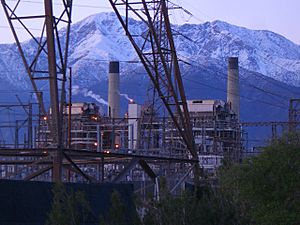
Transportation
Rancho Cucamonga is served by Omnitrans bus service, train service from Metrolink's Rancho Cucamonga station on the San Bernardino Line, and nearby Ontario International Airport, one of four major Los Angeles-area passenger airports with multiple daily flights by most domestic carriers as well as a major shipping hub for companies like UPS and FedEx.
Rancho Cucamonga has been identified as the initial western end-point of the Brightline West High Speed Rail (HSR) project to connect Southern California with Las Vegas. On December 5, 2023, it was announced that the project would be awarded a grant of USD3 Billion from the Bipartisan Infrastructure Law.
Interstate 15 (I-15) and State Route 210 (SR-210) run through Rancho Cucamonga as well as the historic U.S. Route 66 (as Foothill Boulevard).
I-15 sits atop an elevated berm, and cuts a curve through the southeastern part of the city, isolating a mostly industrial area, a small shopping center, and several housing tracts from the larger part of the city. Further north, I-15 forms part of the northeastern border with neighboring Fontana before entering the Cajon Pass through the San Gabriel Mountains. I-15 provides connectivity with the High Desert, Nevada, and points north for the Inland Empire and much of Southern California.
Utilities
Rancho Cucamonga receives natural gas from the Southern California Gas Company. The city's water supply and sewage are managed by the Cucamonga Valley Water District. Garbage collection is by Burrtec Disposal, phone service is from Frontier Communications and cable TV is provided by Charter Communications.
Electric power in Rancho Cucamonga is provided by Southern California Edison and the Rancho Cucamonga Municipal Utility.
Before 2024, the city was home to the Reliant Energy Etiwanda Generating Station, on Etiwanda Avenue. This facility, one of five Reliant stations in California, was a natural gas-fired power plant, which began operation in 1963. At 640 MW (860,000 hp) net capacity, it was Reliant's second-highest-capacity plant on the West Coast. It utilized four steam turbine generators; of which units three and four remained active after turbines one and two, as well as a combustion turbine, were retired in 2003 and 2004, respectively. Several systems are in place to control gas emissions, and annually, over 900,000,000 US gal (750,000,000 imp gal; 3.4 GL) of recycled water are used for cooling. As of 2024, all turbines and stacks and the entire electrical plant have been removed.
On November 29, 2011, the Inland Empire Utilities Agency installed the first wind turbine in Rancho Cucamonga.
Notable people
- The Young Bucks (Matt and Nick Jackson), Professional Wrestlers. Current tag-team in All Elite Wrestling
- Ejiro Evero, professional American football coach
- C. J. Stroud, professional American football quarterback, selected second overall by the Houston Texans in the 2023 NFL draft, 2023 Offensive Rookie of the Year
- Nichkhun, singer, songwriter, actor and model. Member of the boy band 2PM
- Frank Zappa, musician who lived in and worked in Cucamonga during the early 1960s. He bought the Pal Recording Studio from a friend, Paul Buff, and renamed it "Studio Z". The studio closed in 1964 when the building was demolished in order to widen Archibald Avenue. ("Cucamonga" is also the name of a long-lived radio show on Radio 1, Belgium, as an obscure reference to Zappa.)
See also
 In Spanish: Rancho Cucamonga para niños
In Spanish: Rancho Cucamonga para niños


